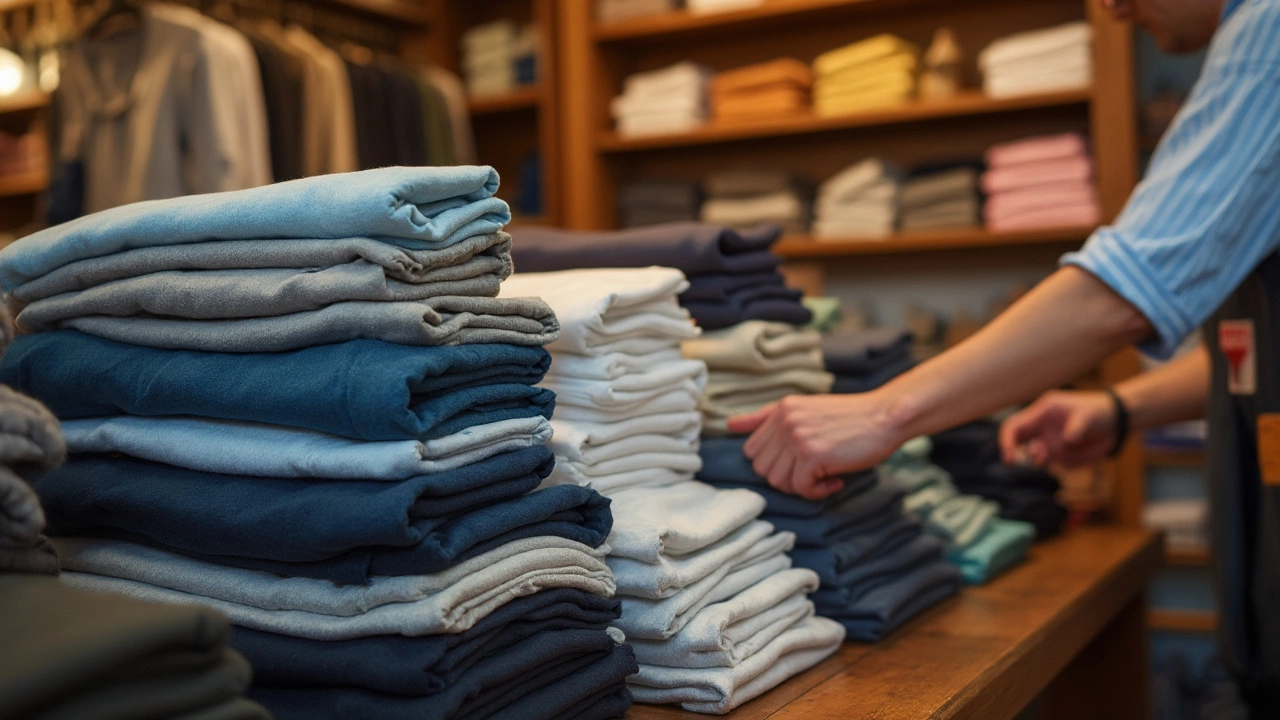Ever been in a London shop wondering if asking for a "T-shirt" would make you stand out? Spoiler: Brits do call them T-shirts, just like Americans. No secret British slang or hidden code—walk into any store, ask for a T-shirt, and you’ll get exactly what you expect.
Some older Brits might say "tee shirt" with a drawn-out emphasis on the "tee," but honestly, that’s rare and sounds a bit old-fashioned. If you’re imagining some quirky UK nickname for your trusty cotton tee, you’ll be disappointed—no one’s calling it a "jumper" or a "vest." Those words mean totally different things in the UK, and mixing them up usually just sparks confusion (and maybe a laugh).
- The British Term for T-Shirts
- Origins and Pop Culture Influence
- Common Nicknames and Variations
- Practical Tips for Buying T-Shirts in the UK
The British Term for T-Shirts
If you’re heading to the UK and worried about local lingo, here’s the truth: Brits call them T-shirts just like anyone else. There’s no secret British slang—whether you’re on Oxford Street or shopping in a backstreet vintage shop, you’ll hear “T-shirt.” It’s written on shop signs, clothing labels, and even in fashion magazines.
Mixing it up with words like “vest” or “jumper” is where travelers get tripped up. In the UK, a vest means what Americans call an undershirt (worn under your clothes), and a jumper is what Americans call a sweater. Ask for a vest when you want a T-shirt and you’ll just get confused looks or pointed to the underwear section. This language gap is real, but thankfully, there’s no confusion over the T-shirt itself.
Some Brits casually say “tee,” but this is just a shortened version, and it’s not formal or regional—teens and young adults might use it in conversation, but you’ll still see “T-shirt” on all the price tags.
- “T-shirt” (common term)
- “Tee” (slang, used sometimes)
Spotting a sign for “fashion tees” in a British store isn’t uncommon, especially in places targeting a younger crowd. But you won’t see quirky alternative terms for this item the same way you do for things like “wellies” (rain boots) or “trainers” (sneakers).
So, if you’re shopping, chatting about outfits, or just trying to blend in, stick with “T-shirt.” You’ll never be misunderstood.
Origins and Pop Culture Influence
T-shirts didn’t actually get their start in the UK; they showed up first in the US around the late 1800s as undershirts. British soldiers spotted them during World War II and thought the idea of a lightweight, comfy top made a lot of sense, especially after sweating in layers of wool under gear. After the war, the style stuck around in Britain too.
The name “T-shirt” is all about its shape—if you lay one out flat, it literally looks like a capital “T.” The British kept the American term, which is why you don’t hear a different word for it in the UK. As far back as the 1950s, T-shirts started making moves in pop culture, thanks to movie icons like Marlon Brando in “A Streetcar Named Desire” and James Dean in “Rebel Without a Cause.” The cool, rebellious vibe caught on both sides of the Atlantic.
British pop and rock culture took things further in the ‘60s and ‘70s. The Beatles and The Rolling Stones had their logos splashed across tees, turning plain shirts into billboards for music fans. By the time the punk scene hit London in the late ‘70s, shops like Vivienne Westwood’s SEX boutique were selling T-shirts with political statements and crazy designs. That gave the T-shirt a new life as a way to show your personality or make a statement.
Here’s some fun perspective: These days, the UK T-shirt market is huge. According to a 2023 report, Brits buy over 118 million T-shirts a year. That’s not just for fashion—people grab them as souvenirs, workwear, gym gear, and everything in between.
So, if you’re wearing a T-shirt in Britain, you’re part of a long history of pop culture, music, and personal style—no matter if your tee’s plain or features your favorite band.
| Year | UK T-Shirt Milestone |
|---|---|
| 1940s | British soldiers adopt T-shirts from US troops |
| 1955 | James Dean inspires the "cool tee" trend |
| 1960s-70s | Band logo T-shirts explode in popularity |
| Late 1970s | Punk fashion puts slogans on T-shirts |
| 2023 | Brits buy 118 million T-shirts in one year |
Next time you throw on a T-shirt in the UK, you’re tapping into all this history—and it’s probably something you haven’t really thought about. That’s the fun part about clothing: Sometimes the simplest items carry the biggest stories.

Common Nicknames and Variations
If you’re hoping to impress your British friends with local lingo, here’s the lowdown: the classic T-shirt doesn’t have many fancy nicknames in the UK. People stick with "T-shirt" almost everywhere you go. You might see it written as "tee," especially in stores or online when describing the style ("graphic tee," "plain tee"). The term "tee" is pretty casual and usually pops up in fashion or marketing rather than in actual conversation.
Here’s where it gets tricky: clothing words like "vest" and "jumper" mean something else entirely. In British English, a vest is an undershirt—think thin, sleeveless, and worn underneath, not out in public. Jumpers are what Americans call sweaters. So if a Brit offers you a vest, don't expect sleeves or a T-shirt vibe at all.
The only other slight twist you might see is for long-sleeve versions. Brits sometimes say "long-sleeve T-shirt" (yes, very literal). Occasionally, you’ll hear "base layer" if it's for sports, but that’s about as wild as it gets.
Check out these UK terms often confused with T-shirts:
- British slang: None for T-shirt, but "tee" is accepted for style types.
- Vest: Always means an undershirt, never a T-shirt.
- Jumper: Sweater, not a T-shirt.
- Polo: Refers to a collared shirt, not a T-shirt.
If you're scrolling UK online shops, sometimes filters will let you pick from "crew neck tee," "V-neck tee," or simply "tops." Don’t be surprised if you land on a page of T-shirts labeled as "tops"—it's just a catch-all term and not something people say out loud much.
| Term | UK Meaning | US Comparison |
|---|---|---|
| T-shirt | Standard short-sleeved top | Same |
| Vest | Undershirt | Tank top/undershirt |
| Jumper | Sweater | Sweater |
| Tee | Casual or marketing term for T-shirt | Same |
If you keep that in mind, you’ll never end up in a shop trying to make sense of British fashion speak—just say T-shirt and you’ll fit right in.
Practical Tips for Buying T-Shirts in the UK
Shopping for T-shirts in the UK can be super straightforward if you know a few local quirks. First off, sizing can trip you up. UK sizes run differently from US ones. Instead of small, medium, and large alone, you’ll often see numbers—so a UK men's medium is usually a size 38-40 inch chest. Women’s T-shirts often go by numbers too, like 10, 12, or 14.
| UK Men’s Size | Chest (inches) |
|---|---|
| Small | 34-36 |
| Medium | 38-40 |
| Large | 42-44 |
Pay attention when you see "vest" or "jumper". In the UK, a vest is a sleeveless undershirt (think of what your grandad might wear under his shirt), and a jumper is a sweater, not a T-shirt. It saves you from an awkward moment in the changing room.
If you're hunting for British slang on T-shirt tags or packaging, you’re unlikely to find much. They’re just called T-shirts everywhere. But if you want something with a bit of local style, look for UK brands like Fred Perry, Superdry, or Marks & Spencer. They carry cuts and patterns that fit UK trends.
- Many UK shops offer unisex fits, but double-check if you're particular about fit or length.
- When buying touristy graphic tees, check the fabric. Some souvenir shops sell polyester blends that don’t last long.
- Watch for seasonal sales—big discounts hit after Christmas and in July.
- If you’re shopping online, use size guides, as returns for the wrong fit can be a hassle from abroad.
Just remember, a T-shirt’s a T-shirt in the UK. You don’t need to crack a code—just know your size, double-check the label, and snag a design that pops.
